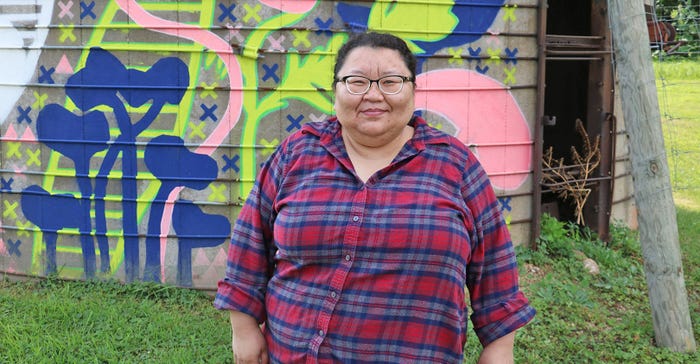September 4, 2019

VISIONARY LEADER: Pakou Hang was instrumental in HAFA’s formation and serves as the organization’s executive director. She will be stepping down from that role at the end of September but will stay with the organization until November.Dan Lemke
By Dan Lemke
Against the backdrop of a bustling Highway 52 south of Saint Paul is one of Minnesota’s most unique farms. The 155-acre patchwork of plots features a wide array of crops from asparagus to zinnias.
Since 2013, the Hmong American Farmers Association (HAFA) has called this parcel home. About 20 Hmong farm families lease one or two 5-acre plots.
“Our farm families raise 165 different varieties of fruits, vegetables and flowers on this farm,” says Pakou Hang, HAFA executive director. “It’s really a robust ecosystem in the best way.”
Creating access
Most of the Hmong farmers working the land at the HAFA Farm live in the Twin Cities metropolitan area and sell their produce at urban and suburban farmers markets. Prior to the HAFA Farm, Hmong growers struggled getting access to land on which to farm.
A former dairy, corn and soybean farm up for sale near the Vermillion River south of Coates became a possible solution. In 2013, Hang says an anonymous benefactor who wanted to support small farms bought the land and arranged for HAFA to lease it. Currently, 125 acres are tilled, providing the Hmong farmers with what they were most lacking — long-term farmland access.
“Maybe they couldn’t access land because it was too expensive, or they didn’t know who the owners were or didn’t know what the terms were,” Hang says. “Most important was they didn’t have access to land tenure. Any farmer will tell you when you know you’re going to have access to farmland for a long time, you think differently about that land.”
Hang says the certainty of available land helps farmers to think more long term. Farmers now have more planting options and can develop more long-range plans.
“Now farmers can invest in perennials, or maybe invest in some sort of organic certification because that will mean a higher premium product that can be marketed differently,” Hang says. “When you don’t have that, then [you’re] only doing what you can to optimize growth for that year, so you may not be thinking holistically.”
In addition to farmland, the HAFA Farm includes washing and packaging areas required to meet food safety guidelines for mixed vegetables. The farm is also used for training and education to help the Hmong farmers look at other crop opportunities and improve their productivity.
Hang says about 60% to 65% of what the farmers grow goes to local farmers markets in the Minneapolis and Saint Paul area. The remaining 35% to 40% goes to the HAFA Food Hub. The hub accepts food from farmers, aggregates it and then sells and delivers the farm-raised produce to school districts, grocery stores or restaurants. Hang says the food hub delivers fresh produce to 24 different school districts.
“We estimate that we’re feeding over 240,000 people through the schools, colleges and early childhood development programs,” Hang says. “The food from this farm is really reaching a lot of people in the metropolitan area.”
The ultimate goal, according to Hang, is for the growers to have their own marketing cooperative.
Just the beginning
As a new nonprofit in 2012, Hang says it was hard to convince lenders to invest in HAFA. As a Yale-educated former analyst for a social investment firm, Hang used some of her connections to locate the anonymous benefactor who purchased the land with the purpose of eventually selling it to HAFA or an organization of their farmers.
“In the meantime, HAFA gets a sense of how to run a farm, our farmers get access to the farm and begin to work the land and see what they can learn from it. It’s been a win-win for everybody,” Hang says. “In the next couple of years, we hope to make the decision and start raising funds to be able to buy the land.”
Hang says HAFA’s mission is to lift up the economic prosperity of their farmers, so they can build intergenerational community wealth.
“I want a Hmong family to one day have a business and be able to say we built this business because years ago, our parents or great-grandparents were HAFA members,” she says. “That business doesn’t have to be agriculture, but that initial wealth, that investment came from this nonprofit, from this operation.”
Another goal is for the growers is to build enough wealth to be able to purchase their own farms.
Hang sees the HAFA farm as a pathway to greater prosperity among Minnesota’s Hmong farming community.
“I remember growing up as a kid being embarrassed that my parents were farmers. They weren’t doctors, they weren’t lawyers, they were just farmers. They were people who worked with their hands,” Hang says. “One of our goals at HAFA is that the children, grandchildren and great-grandchildren can look back on what their elders did with pride to see how smart, how innovative and entrepreneurial they were, to really reframe how we think about immigrant farmers.”
Lemke writes from Madison Lake, Minn.
You May Also Like




